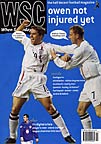 The Football League play-offs present altering patterns in hooliganism, writes Tom Davies
The Football League play-offs present altering patterns in hooliganism, writes Tom Davies
If there’s a World Cup in the offing, one thing you can always rely on in the preceding weeks is the “spotlight” falling on “fears of hooliganism”. With it comes the obligatory bout of documentaries on “the problem that never went away”, as a seemingly endless stream of ageing young men queue up to tell us about where and why it’s kicking off. Proclaiming yourself to be a former football hooligan must surely be the easiest way to achieve TV fame these days – such people make the contestants on Pop Idol look like dues-paying footsloggers by comparison.
And just before these summer tournaments, there is always an ideal laboratory in which the problem can be examined: the play-offs, with all their attendant passion and tension. It just so happened that this year’s matches threw up something of a hoolie bonanza, with Millwall paired with Birmingham in the First Division semi-finals, and Cardiff and Stoke facing off in the Second. Major public disorder, almost inevitably, ensued. But it would be misguided to read the events in Cardiff and South Bermondsey as evidence that violence is necessarily getting out of control again.
The play-offs have always been trouble-prone, from the famous Chelsea v Middlesbrough tear-up in 1988 (when the final was still a two-legged affair), through the riot at the New Den in 1994 after Derby pipped Millwall to a final place, and problems at Stoke’s First Division semi with Leicester in 1996. Even in the Third Division, Hull fans wrecked a pub in Leyton before their tie at Orient last year, an incident which led, comically, to practically every pub in the area being closed when the two teams met again this year for a tepid, meaningless end-of-season goalless draw.
So the play-offs bring problems, as promotion cliff-hangers have done for decades, and yet the finals themselves rarely generate significant trouble. Maybe it’s the neutral venue, which takes out of the equation the whole game of taking and defending your “manor”. Maybe it’s the general numerical equality of the two sets of fans. Maybe, even, it’s the “here for the day out” mentality (though I doubt it – no one takes play-off finals lightly and no one actually enjoys them, dear me no). Whatever the reason, usually everyone wears colours and no one gets hurt.
Perhaps, had Millwall and Cardiff progressed to their respective finals, that colourful idyll would have been shattered in the streets around the Millennium Stadium, but then these two clubs have just about the most intractable hooligan problems in the League anyway, as the recent documentaries have illustrated.
Like most people in the country, I first learned of the Millwall riot the following morning. Unlike them, I’d actually been at the game (as a neutral), sitting in the stand nearest the visiting fans and populated by the Lions’ most voluble fans. For most fans, even matches as combustible as this are still generally safe to attend. But that is little consolation to the beleaguered residents of South Bermondsey, cowering in their homes as the boys play their games in the streets outside.
From WSC 185 July 2002. What was happening this month